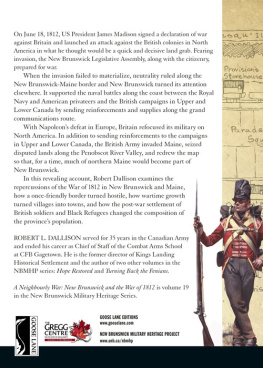The 104th (New Brunswick) Regiment of Foot in the War of 1812
New Brunswick Military Heritage Series, Volume 21
Chapter One
Garrison Duty in New Brunswick, the War of 1812, and the March to Kingston
In all respects fit for any service.
Inspection Report, 104th Foot, June 1812
The Kings New Brunswick Regiment, The New Brunswick Fencible Infantry, and the Formation of the 104th Foot
During the eighteenth century, a series of conflicts shaped the early political boundaries of North America. By 1783, three major political groupings had emerged: Britain held colonies in the northeast; to the south were the United States of America; and to the west, the colonial holdings of Spain. A commercial company, the Hudsons Bay Company, controlled a vast tract of land in the northwest. The First Nations peoples inhabiting these territories did not always recognize these boundaries, which remained ill-defined for nearly a century. Ongoing competition between the respective governments for additional territory and fears for their own security soon combined with wider political differences in Europe to ensure another war in the early nineteenth century.
Even with the loss of thirteen of its North American colonies in 1783, Britains colonial possessions in the New World remained vast, with the largest group of colonies becoming known collectively as British North America: the provinces of Quebec and Nova Scotia, the Island of Cape Breton, the Island of St. John (later, Prince Edward Island), and Bermuda; the Colony of Newfoundland was not included in this structure. The displacement of a large number of refugees from the United States, popularly known as Loyalists but also including a significant number of First Nations peoples, to the remaining British colonies and to Britain transformed the boundaries of British North America. In 1784, the province of Nova Scotia was partitioned and the province of New Brunswick created, while in 1791, the province of Quebec was divided into the largely English-speaking province of Upper Canada and the predominantly French-speaking Catholic province of Lower Canada.
In general terms, peaceful relations dominated the years immediately following the American Revolutionary War. The most serious threat occurred on the west coast, where, in 1789, the establishment of a Spanish outpost at Nootka, on Vancouver Island, nearly led to war between Spain and Britain. The peaceful conclusion of this crisis by treaty in 1790 was followed four years later by a reduction in tensions with the United States. The Treaty of Amity, Commerce and Navigation, more popularly known as Jays Treaty after the senior American negotiator, John Jay resolved many of the boundary disputes between the United States and the British colonies to the north. Despite the rapprochement, however, mutual suspicion remained, and the ongoing war between the United States and First Nations groups in Ohio and the Michigan and Illinois Territories had the potential to spill over into Upper Canada.
These events, however, were minor against the backdrop of a wider global war that erupted in 1793, when Britain joined a coalition of several European countries to oppose revolutionary France. As France defeated its opponents on the continent, Britains command of the sea allowed it to secure several important victories in the Mediterranean and the West Indies.
The perceived threat to the Atlantic provinces from both France and Spain fuelled public support and saw a swelling of willing recruits for military service. In July 1793, a French naval squadron with 2,400 troops arrived off New York, where they began recruiting Americans and seeking the support of the United States for an attack on the British Atlantic colonies. The threat posed by the French using Saint-Pierre and Miquelon as naval bases to strike at the Atlantic provinces was removed in May 1794 when a contingent of four hundred British soldiers and members of the Nova Scotia Regiment took the islands. The appearance of a
Although the British relied upon regular troops to defend their North American provinces, the active theatres in Europe and the West Indies left few such troops available for service elsewhere. The colonial militia forces, raised from among all able-bodied men ages sixteen to sixty and controlled by each province, were inadequately trained, and lacked much of the necessary arms and equipment to be useful in the field. The fortifications protecting key points, such as cities and harbours, were in a poor state or lacked ordnance.
The military situation in New Brunswick was acute. Since 1790, Governor Thomas Carleton had warned of the exposed state of the communities along the Bay of Fundy, the ruinous state of the fortifications, and the lack of arms. The impending withdrawal of the last British regulars from the province would leave the militia responsible for repelling any attack. Unfortunately, little had been done to prepare the force created by the 1787 militia act. Many companies and regiments lacked a full complement of men, and many of the officers owed their appointments to political patronage, rather than to martial skill. Musters were dominated by administrative activity and social events, and the lack of weaponry provided few opportunities for effective drill instruction. Fortunately, by 1791, British officials had presented a solution for improving the state of the garrisons throughout British North America with the creation of fencible and provincial regiments.
Although they had ancient precedents, fencible regiments originated during the Seven Years War when Britain established several such regiments to defend itself from invasion. Equipped, trained, disciplined, and paid as regulars, fencible infantry and cavalry regiments were raised with the understanding that their deployment would be restricted to within national boundaries or other specified geographic areas, such as a county, and that their service could be extended abroad only by their volunteering for this service. When the war with France began in 1793, Britain
Beginning in 1791, fencible regiments were raised in several provinces of British North America. Among the units were the Queens Rangers in Upper Canada, the Royal Nova Scotia Regiment, the Island of St. Johns Volunteers (from 1800, the Prince Edward Island Fencibles), and the Royal Newfoundland Regiment. In 1794, the two-battalion Royal Canadian Volunteers was divided between Upper Canada and Lower Canada.
Provincial regiments presented another means of augmenting local forces. Normally raised for the duration of a conflict, they were officered by professional officers, dressed, equipped, and trained like regulars, and employed in a specified geographic area, although they often ventured outside their boundaries. The appeal of this type of unit was that it provided a solution to a local problem by bolstering the defences vacated by regular troops, at less cost than a regular regiment. The specifics regarding officers commissions, the pay and benefits to officers and the rank and file, employment of the regiment, and command and control varied with the orders provided for the raising of each provincial unit.
In February 1793, given the state of New Brunswicks defences, the Secretary of State for War, Henry Dundas, instructed Governor Carleton to raise a six-hundred-strong unit to be known as The Kings New Brunswick Regiment. The regiment was to be headquartered in Fredericton, and the posting of six of its companies to Fredericton, Saint John, and St. Andrews would allow the withdrawal of the 6th Foot, the last regular regiment in the province, for employment in the West Indies. Carleton, who welcomed this decision and became colonel of the regiment, controlled the officer appointments. All officers above the rank of ensign were selected from a list of half-pay officers or were veterans of the American Revolutionary War. As the regiment was merely provincial and for the service of New Brunswick only,
Next page






